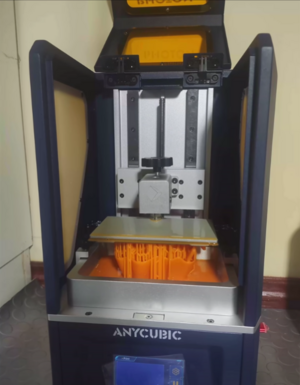Vat Polymerization: Difference between revisions
Jump to navigation
Jump to search
No edit summary |
No edit summary |
||
| Line 6: | Line 6: | ||
The benefits of Vat Polymerization : | The benefits of Vat Polymerization : | ||
* fine detail: since detail is limited by screen resolution this allows for extremally fine details, and an excellent surface finish | * '''fine detail:''' since detail is limited by screen resolution this allows for extremally fine details, and an excellent surface finish | ||
*clear parts: the fine detail, and material used allows for vp printing to create more clear parts then other processes | *'''clear parts:''' the fine detail, and material used allows for vp printing to create more clear parts then other processes | ||
The drawbacks of Vat Polymerization: | The drawbacks of Vat Polymerization: | ||
* Toxic materials: Most materials that VP printers use are generally extremally toxic, and should be handled with care. protective equipment should be worn, And vp printing should always be done with proper ventilation to protect against toxic fumes. | * '''Toxic materials:''' Most materials that VP printers use are generally extremally toxic, and should be handled with care. protective equipment should be worn, And vp printing should always be done with proper ventilation to protect against toxic fumes. | ||
* weaker material properties | * '''weaker material properties:''' resins tend to be brittle and not very tough | ||
* post processing: VP parts need to be cleaned of wet resin, and | * '''post processing:''' VP parts need to be cleaned of wet resin, and recured | ||
*Resin degradation: resins tend to degrade in color and strength over time. especially if exposed to the elements | *'''Resin degradation:''' resins tend to degrade in color and strength over time. especially if exposed to the elements | ||
{| class="wikitable" | {| class="wikitable" | ||
Revision as of 10:51, 29 September 2023
Process description
Vat polymerization was the first additive manufacturing developed in 1986 by Charles hull. it starts with a print plate being lowered to the top of a vat filled with a photoreactive resin. a light source is then used to cure the first layer direct on the build plate. the build plate is then raised so the next layer can be cured directly onto the last. this is repeated until the part is complete. the part then must be put through a washing process, and then a final cure with a strong light.
Strengths & Weaknesses
The benefits of Vat Polymerization :
- fine detail: since detail is limited by screen resolution this allows for extremally fine details, and an excellent surface finish
- clear parts: the fine detail, and material used allows for vp printing to create more clear parts then other processes
The drawbacks of Vat Polymerization:
- Toxic materials: Most materials that VP printers use are generally extremally toxic, and should be handled with care. protective equipment should be worn, And vp printing should always be done with proper ventilation to protect against toxic fumes.
- weaker material properties: resins tend to be brittle and not very tough
- post processing: VP parts need to be cleaned of wet resin, and recured
- Resin degradation: resins tend to degrade in color and strength over time. especially if exposed to the elements
| Low | High | |
|---|---|---|
| volume X/Y/Z (mm) | 96/54/127 | 380/380/250 |
| resolution (mm) | .05 | .003 |
| layer height (um) | 15 | 25 |
| price ($) | 450 | 500,000 |
Technologies
There are a number of specific technologies that can vastly change to capabilities of a printer.
- Digital Light Processing: uses a projection of the layer to cure the entire thing at the same time. this makes it very fast but with the trade off of decreasing accuracy.
- Stereolithography: uses a light beam to cure a layer one line at a time, this makes it accurate, but slower
